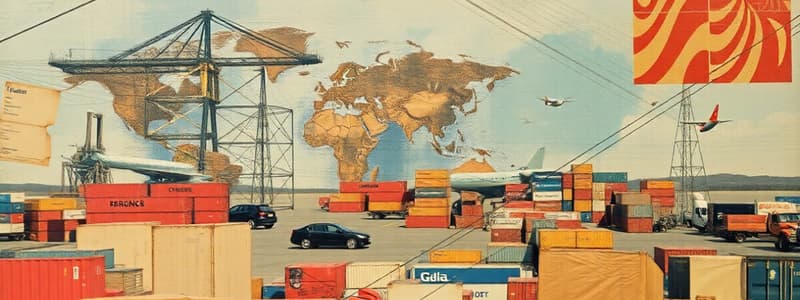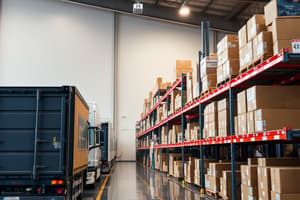Podcast
Questions and Answers
Which of the following best describes the role of international hubs in logistics flow?
Which of the following best describes the role of international hubs in logistics flow?
- They primarily serve domestic logistics needs.
- They function as a warehouse or facility that supports various transportation methods along the supply chain. (correct)
- They operate independently from the supply chain to expedite transportation methods.
- They focus on minimizing transportation methods to reduce logistics costs.
In a 'many to one' hub configuration, what is the primary function of the origin consolidation hub?
In a 'many to one' hub configuration, what is the primary function of the origin consolidation hub?
- To distribute goods directly to the end customer.
- To deconsolidate goods for multiple consignees.
- To store goods for an extended period before distribution.
- To consolidate cargo from multiple suppliers into a full container load (FCL) for a single destination. (correct)
How does leveraging multi-mode transportation at Regional Distribution Centers (RDCs) or Global Distribution Centers (GDCs) enhance transportation management?
How does leveraging multi-mode transportation at Regional Distribution Centers (RDCs) or Global Distribution Centers (GDCs) enhance transportation management?
- It increases reliance on a single mode of transportation to minimize costs.
- It primarily focuses on using long-haul air transport to expedite delivery.
- It enables the deployment of the most appropriate transport method based on inventory needs. (correct)
- It limits the transportation options to reduce complexity.
What is a key characteristic of a Bonded Logistics Park (BLP) in China that differentiates it from other international hubs?
What is a key characteristic of a Bonded Logistics Park (BLP) in China that differentiates it from other international hubs?
Which of the following is a primary benefit of multi-country consolidation (MCC) for a business, as highlighted in the case study?
Which of the following is a primary benefit of multi-country consolidation (MCC) for a business, as highlighted in the case study?
Flashcards
What is an International Hub?
What is an International Hub?
Acts as a warehouse/facility along the supply chain, supporting multiple transportation methods at a country or provincial level.
What is "1 to many"?
What is "1 to many"?
A destination deconsolidation center where one supplier loads a Full Container Load (FCL) that ships to a deconsolidation center for breakbulk. Useful for optimizing volume.
What is "Many to 1"?
What is "Many to 1"?
Multiple suppliers deliver cargo to a consol center. Cargo is planned, consolidated into a FCL and shipped to its destination without the container seal being opened until it arrives.
What is a Bonded Logistics Park (BLP)?
What is a Bonded Logistics Park (BLP)?
Signup and view all the flashcards
What is Multi-country consolidation (MCC)?
What is Multi-country consolidation (MCC)?
Signup and view all the flashcards
Study Notes
Connotation of Hubs
- Hubs are known at the country or provincial level
- Singapore/Hong Kong are global logistics hubs
- Malaysia functions as an ecommerce hub
- Chongqing acts as an intermodal hub
- International logistics flow involves hubs as part of the process
- Hubs are warehouses or facilities along the supply chain
- Hubs support various transportation methods
- The discussion focuses on international hubs versus domestic hubs
Location of International Hubs
- CFS Origin Hub are located near suppliers
- GDC, RDC, and MCC Hubs are intermediate points
- Decon Centers are used for deconsolidation
- Domestic Hubs/ Warehouses and consignees are at the destination points
Hubs and Transportation Methods
- Hubs support various transportation methods:
- 1 to 1
- 1 to many
- Many to 1
- Many to many
1 to 1 Transportation
- One supplier location ships to one consignee location
- Different modes of transport can be used
- Ocean FCL
- Airfreight
- Rail FCL
- Road X-border
- Intermodal
1 to Many Transportation
- Destination deconsolidation center serves as an example
- One supplier loads a Full Container Load (FCL)
- Goods are shipped to a decon center for breakbulk
- Cargo is cross-docked into multiple box trucks for delivery to multiple destination warehouses
Multiple "1 to many" Flows
- Several "1 to many" flows converge at the decon center
- Convergence creates added efficiency in cross-docking activities
Many to 1 Transportation
- Origin consolidation hub serves as an example
- The concept is found in Buyer's consolidation discussions
- Many suppliers deliver cargo by truckloads to a consol center
- Cargo is planned and consolidated into an FCL which has the same final destination WH
- The FCL is shipped without opening the container until it arrives at final destination
Requirements for Many to 1
- End-to-end (E2E) planning is required
- Plan according to cargo ready dates (CRD), container loading, and in-DC dates
- Activities at origin hubs include cross-docking for short dwell times, and storage for long dwell times
3PLs and Buyer's Consolidation
- Large 3rd Party Logistics providers operate origin hubs across their network in the Buyer's consolidation space
BLP in China
- Bonded Logistics Parks (BLP) in China act as int'l hubs
- BLPs consolidate cargo China and overseas suppliers
- The cargo is stored and redistributed to overseas markets
- Cargo shipped into BLPs from either domestic or overseas suppliers get instant VAT refund or are bonded
- Due to it's large export volumes, the BLP model is different than the HK or Singapore models
Chinese Government and BLPs
- BLPs have two targets for the Chinese government:
- To attract international goods movements, and build China’s own international ocean freight hubs
- To improve logistics service for all enterprises in the regions
BLP Establishments
- BLPs are established in most coastal cities in China, including:
- Dayaowan
- Tianjin & Dongjian
- Qianwan
- Zhangjiagang
- WGQ & Yangshan
- Meishan
- Fuzhou
- Xiangyu & Haicang
- Yantian & Qianhaiwan
Waigaoqiao BLP Space Allocation
- Shanghai’s Waigaoqiao BLP has 1.02 sq KM of allocated space
- Established in April 2004
- Total Park Size 1.02 sq km
- 278,300 Sqm available warehouse space
Multi-Country Consolidation
- Multi-country consolidation (MCC) is an international mixing hub
- Includes cross-dock and short dwell times
- Optimizes container utilization
- Diverts small cargo flow (LCL)
Regional Distribution Center
- Is another type of hub
- Stocks inventory
- Services provide added value
- Can provide longer dwell times
- Optimizes container utilization
- Diverts small cargo flow (LCL/Air/Road)
FTA impact on hubs
- FTA savings can impact choice of hub, which effects how cargo is transported
- The transport department needs work with the trade compliance department
- This is to gain a holistic view on logistics strategy
Shipper/consignee and incoterm
- The shipper/consignee may or many not be the party that gain from saved import duties
- This involves the seller or buyer which adds to the complexity to decision making
Studying That Suits You
Use AI to generate personalized quizzes and flashcards to suit your learning preferences.





